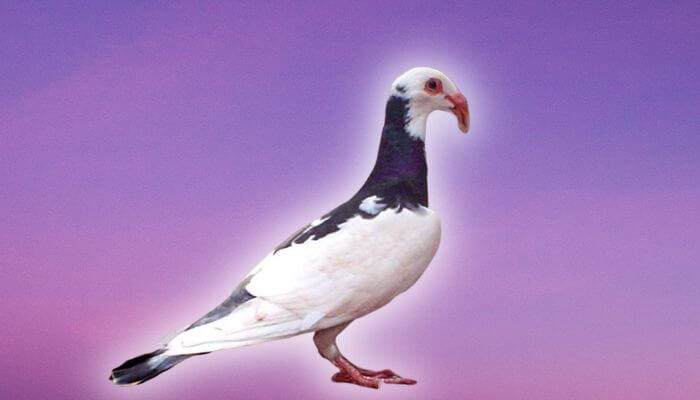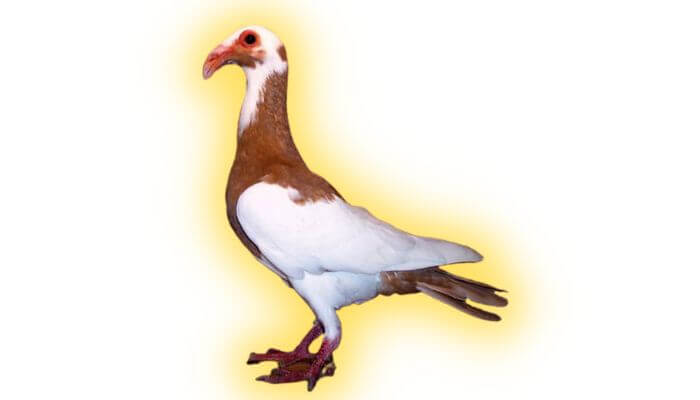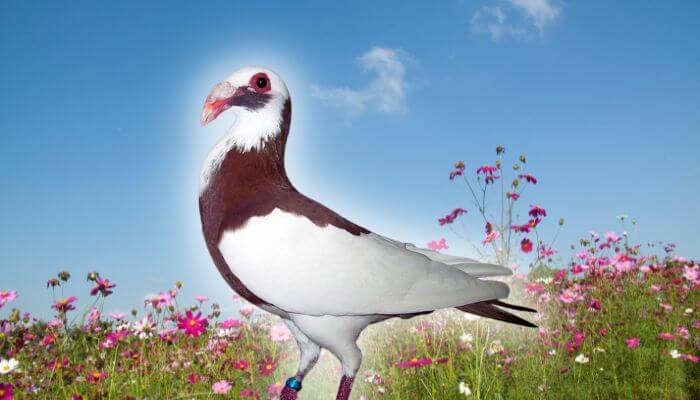The Scandaroon pigeon is not an overly common breed of fancy pigeon with a distinctive look that resembles more that of a chicken than a pigeon.
Like many breeds of pigeon, Scandaroons were bred for meat production in the past because of their size, but modern breeders now raise them for exhibition and as pets.

Origins of the Scandaroon Pigeon
This breed was first written about by an Italian professor of natural sciences called Ulisse Aldrovandi in 1599 in his book on ornithology.
They were labeled Columba turcica or Columba persica.
Their common names were Scandaroon in England speaking parts and Neurenberger Bagadet in the Netherlands.
It is speculated that the Scandaroon breed actually came from Persia.
They were introduced to Western Europe from the Middle Eastern ports.
It is said that their original name was Scadaroon.
This name was taken from the town in which they were supposedly bred, according to one John Moore in 1735.

Another theory is that the Scandaroon is the Turkish word for Alexander and its name is derived from the belief that Alexander the Great used the breed as a message carrier.
This being the case, the Scandaroon is a very ancient breed.
It is believed that the first breeding pair was purchased in the Turkish port town of Iskenderun, which is on the Turkish/ Syrian border.
The Turks called them Bagatin.
Scandaroon is probably a western corruption of Scadaroon or Iskenderun that began when merchants first took this particular breed to Europe.
The city of Nuremberg in Germany, a prosperous commercial center of the time seems to be their destination and they have spread to other pigeon breeders throughout Europe from there.
Although they can be found in England, France and the Netherlands, the western European breed was developed in Germany.
They go under the name Nuremberg Bagdette in Germany, Neurenberger Badadet in the Netherlands and Bagadais de Nuremberg in France.
There are several types of these birds, but they are all grouped together under the name Bagadet.
Scandaroon pigeons were among the pigeons kept by Charles Darwin.
Distribution and Habitat of the Scandaroon Pigeon
As a selectively bred pigeon, its habitat is entirely domestic and distribution is as per ownership.
There are no wild Scandaroon pigeons.
Appearance of Scandaroon Pigeons
| Wingspan | Length | Weight | Coloring | |
|---|---|---|---|---|
| Scandaroon Pigeon | 70 – 75 cm | 42 – 43 cm | 500 – 600 g | Pied, white, black, blue, red and yellow |
| Average Feral Pigeon | 64 – 72 cm | 32 – 37 cm | 300 – 500 g | Bluish grey with some black |
One of the most distinctive breeds, the Scandaroon is a tall bird with a long neck and legs.
They also have large feet.
Scandaroons are also larger than the average feral or domestic pigeon and have a proud and erect bearing.
The head is elongated and the beak is not like the usual pigeon beak but is very strong and curves downwards.
It looks like it should belong to a raptor, not a pigeon.
Apart from their stately posture, their bright eyes and red-eye cere make them stand out.
The eyes are a striking feature of these birds.
The Scandaroon pigeon is a great example of how selective breeding can produce different characteristics even in countries close together.
There are three recognized types of European Scandaroons: English, French and German.
The English is the smaller of the three and has a more curved beak and smaller feet.
The German is larger in size and weight with a longer, stronger beak and bigger feet.
The French is taller, more upright and slimmer (and named the French Baghdad).

They have been variously described as ugly, beautiful, unusual abnormal and extreme for their characteristics.
Colors of the Scandaroon include white, black, blue, red and yellow.
In the UK, they generally pied with a white head, a colored patch under the beak, wings that are mainly white and a colored tail.
Character of the Scandaroon Pigeon
These birds are calm, quiet, intelligent and interesting pigeons to keep.
They are sociable with humans and this makes them good pets.
A strange trait of these pigeons is that they aren’t very tolerant of their own kind.
Scandaroons housed together tend to squabble amongst themselves.
They do, however, get along fine with other breeds of pigeons.
The Scandaroon pigeon was once more than a decent flier but is no longer used for competitive flying.
It is a hardy bird and has been bred to happily withstand the climatic conditions of temperate northern Europe.
Diet of the Scandaroon Pigeon
Despite having what might be described as an irregular beak for one of the Columbidae family, the Scandaroon diet is generally what a pigeon eats.
Most pigeons are granivorous and their diet is seeds, grasses, cereal, nuts and some fruit.
Every owner will have their own idea of the best food.
Some will buy a proprietary food while others will mix their own to ensure the minerals and vitamins pigeons need.
Mating and Breeding Scandaroon Pigeons
When first introduced to Europe there was some concern about their parenting abilities.
Their young squabs were slow to develop.
It was difficult for other birds to foster Scandaroon chicks because of the different shape of their beaks but the breed has developed to become excellent parents.
As a fancy breed, breeders aim to accentuate the most desirable features when choosing a pair to match.
Many years ago, (mostly in Germany), breeders would manipulate babies’ beaks to enhance their curvature but this is no longer practiced.
The breeding process is the same as pigeons generally – 1 or 2 eggs per clutch, incubated for 12-15 days. with both parents taking on the duties of looking after the eggs and the hatchlings.
Overall, the Scandaroon pigeon is a very interesting breed to look at and easy to raise.
